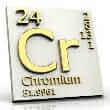Background
- Chromium is an essential trace element that exists naturally in trivalent and hexavalent states. Trivalent chromium (chromium/Cr III), typically found in foods and supplements, appears to have very low toxicity and a wide margin of safety. Hexavalent chromium (chromic oxide, chromate) is a known toxin and long-term occupational exposure may lead to skin problems, a perforated nasal septum, and lung cancer.
- Although chromium has been suggested for many conditions, there is not enough information to make any strong recommendations at this time. Chromium is available in several forms, such as chromium-enriched yeast and chromium picolinate. Chromium has been studied for its short-term and long-term effects. Chromium picolinate is the most studied synthetic chromium product that is commonly promoted for weight loss, although there is a lack of research to support this.
- Chromium may alter blood sugar levels, which should be closely monitored in people with diabetes.
References
Natural Standard developed the above evidence-based information based on a thorough systematic review of the available scientific articles. For comprehensive information about alternative and complementary therapies on the professional level, go to . Selected references are listed below.
- Amann BL, Mergl R, Vieta E, et al. A 2-year, open-label pilot study of adjunctive chromium in patients with treatment-resistant rapid-cycling bipolar disorder. J Clin Psychopharmacol 2007 Feb;27(1):104-6.
View Abstract - Anderson RA. Chromium in the prevention and control of diabetes. Diabetes Metab 2000;26(1):22-27.
- Bahijri SM, Mufti AM. Beneficial effects of chromium in people with type 2 diabetes, and urinary chromium response to glucose load as a possible indicator of status. Biol Trace Elem Res 2002;85(2):97-109.
- Balk EM, Tatsioni A, Lichtenstein AH, et al. Effect of chromium supplementation on glucose metabolism and lipids: a systematic review of randomized controlled trials. Diabetes Care 2007 Aug;30(8):2154-63.
View Abstract - Campbell WW, Joseph LJ, Anderson RA, et al. Effects of resistive training and chromium picolinate on body composition and skeletal muscle size in older women. Int J Sport Nutr Exerc Metab 2002:12(2):125-135.
- Davidson JR. Abraham K, Connor KM, et al. Effectiveness of chromium in atypical depression: a placebo-controlled trial. Biol Psychiatry 2003;53(3):261-264.
- Fowler JF. Systemic contact dermatitis caused by oral chromium picolinate. Cutis 2000;65(2):116.
- Hockney RA, Montgomery P, Williams C, et al. Lack of effect of chromium supplementation on mental state and body weight in people with schizophrenia. J Clin Psychopharmacol 2006 Oct;26(5):544-5.
View Abstract - Hoeger WW, Harris C, Long EM, et al. Four-week supplementation with a natural dietary compound produces favorable changes in body composition. Adv Ther 1998 Sep-Oct;15(5):305-14.
View Abstract - Jovanovic L, Gutierrez M, Peterson CM. Chromium supplementation for women with gestational diabetes mellitus. J Trace Elem Exp Med 1999;12(2):91-97.
- Kleefstra N, Houweling ST, Bakker SJ, et al. Chromium treatment has no effect in patients with type 2 diabetes in a Western population: a randomized, double-blind, placebo-controlled trial. Diabetes Care 2007 May;30(5):1092-6.
View Abstract - Lenz TL, Hamilton WR. Supplemental products used for weight loss. J Am Pharm Assoc (Wash DC) 2004;Jan-Feb, 44(1):59-67; quiz, 67-68.
- Lydic ML, McNurlan M, Bembo S, et al. Chromium picolinate improves insulin sensitivity in obese subjects with polycystic ovary syndrome. Fertil Steril 2006 Jul;86(1):243-6.
View Abstract - Pei D, Hsieh CH, Hung YJ, et al. The influence of chromium chloride-containing milk to glycemic control of patients with type 2 diabetes mellitus: a randomized, double-blind, placebo-controlled trial. Metabolism 2006 Jul;55(7):923-7.
View Abstract - Pittler MH, Ernst E. Dietary supplements for body-weight reduction: a systematic review. Am J Clin Nutr 2004;Apr, 79(4):529-536.







